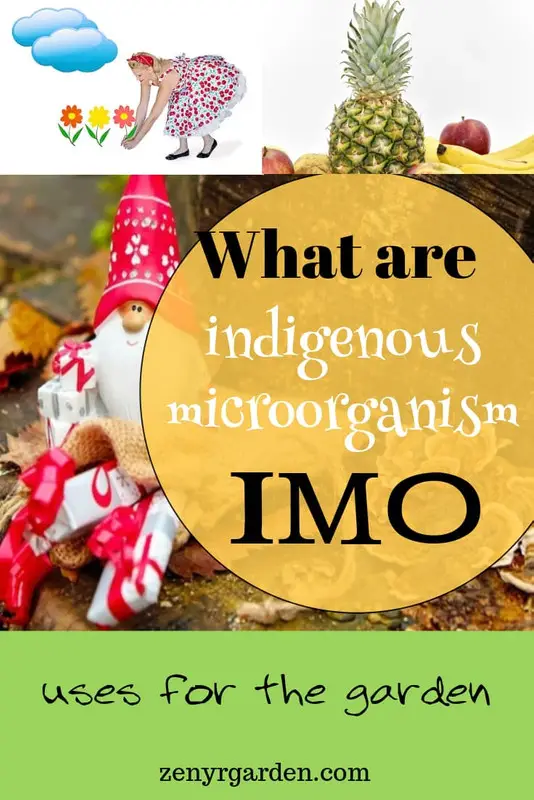Indigenous microorganisms (or IMO for short) are the native microbes that live around your local environment. They can be microscopic bacteria or tiny fungi that aren't visible to the naked eyes. They live everywhere in the air, the water or the foods that we eat.
The reason people culture IMO is because they help break down the organic matter in compost piles, reduce foul smell around ponds or chicken coops, and even fertilize plants in the garden fast and cost-effectively.
People use native microbes because they have been adapted to the heat and cold of the local environment for some time, thus are potentially more resilient. These microbes are easy to 'catch' and reproduce fast.
Another idea for kind of 'hunting' these microbes is that the stuff that carry it is edible. Meaning, unlike chemical fertilizers, the fertilizer that we make with the microbes can actually be consumed safely by humans or other animals.
It thus doesn't destroy but nurtures and encourages other life forms in running eco-system of the soil. In a way, it's like feeding yogurt to your soil. In a way, the idea is Food = fertilizer and fertilizer = food.
Through bio-mimicry using IMO, you can work in harmony with nature and achieve results which would otherwise take years/decades or even centuries to achieve. This thing can work in days/weeks/months right in your garden.
In a way, IMO are similar to EM (effective microorganism). In these mixes, we're trying to cultivate the beneficial microbes that are already existent in our surrounding environment.
This helps first of all in reducing costs because we don't have to import materials from places far away. Also, the local microbes have an advantage over the more foreign ones because they have been adapted to the local environment for quite some time. They are the survivors and thus stronger than some previous generations.
Let's take a look:
Inside an IMO Mix
People usually use a solid form or a liquid form to make IMO. You can use rice grains to attract and house these guys or use water as a living environment to house them.
Usually, in an IMO mix, you'll find:
- Beneficial bacteria (like lactic acid bacteria found in yogurt)
- The native microbes
- Enzymes
- Good fungi/white fuzz
- Sugar
- Water
The solution will have a slight acidic smell with a thin layer of fuzz on top.
Here is IMO in a solid form:
/imo-mycellium.jpg)
We can also use a liquid form to make it:
/mix-the-imo.jpg)
So what are the applications of indigenous microorganisms?
Here Are the IMO Uses
With this IMO solution, you can mix it using a 1:20 or 1:50 ratio with water to spray around piggeries or smelly chicken coops. If the mix is well made (meaning the microbes are active and alive), within about 5-10 minutes after spraying, you will no longer notice any offensive smell. The results are lasting.
Because of the high microbial activity inside the IMO mix, you can use it to directly feed your plants. Depending on the type of plants you're growing & the potency of the mix, a ratio of 1 : 100 to 1 : 500 should work fine.
Blueberries will love a slightly acidic mixture like IMO as they are a type of tree that likes a bit more acidity. For other plants, you might need to dilute it more to reduce the acidity.
When you spray IMO around your fruit trees like grapefruits, you'll see them develop noticeably much larger fruits than they would without the IMO. The fruits are safe and tasty because there are no harmful chemicals used.
Unlock Nutrients For Plants
With these microbes added into the soil, it helps unlock the nutrient pathways that would otherwise be locked or hard for the plants to get and digest.
For example, it can help unleash calcium which may be impenetrable in cases when there's too much nitrogen in the soil.
Inside the IMO mix itself are numerous other good bits (broken down foods, enzymes) that can speed up the chopping up of long-chained nutrients and get digested easily by the plants.
Decontaminate Ponds
IMO also works well to de-contaminate polluted ponds. It helps reduce the pH of highly alkaline ponds (pH ~9) so fishes can live in the water.
With good microbes in, they also ward off the bad guys, making the water more clear and less toxic.
Ward Off Pests
When mixed with ingredients like chili peppers, lemongrass or garlic, the IMO mix can help ward off pests around the garden. If you include some more slimy organic matter like aloe vera, it can help catch mealybugs quite well.
>> Link Blog post: How to make herbal EM to ward off pests
For Compost
IMO helps speed up the compost process & get rid of any unpleasant smell. If you mainly harvest fungi-dominant IMO, then you can throw that stuff inside a fungi-dominant compost to help with the process.
If you're heading for a more bacteria-dominant IMO, then you can dump that stuff in the bacteria compost pile. From that then, we can continue on to make compost tea that would again be used to nourish the soil and the plants.
However though:
The Key Benefit of IMO
One big benefit of IMO is that once you learn how to make it, you can continue on multiplying it for longer and more uses. And as you may have guessed, it is a renewable resource for farms and gardens.
From the first IMO generation, you can keep some of that population & feed them with good food (mainly sugar or minerals). Then, you can get the second, third and so on generations.
By doing this, you don't have to rely on any undesirable chemicals to grow your plants or clear the ponds. You can more effectively reduce the costs on farms and gardens while making it easier on you and the things around you.
Share or pin this post!


